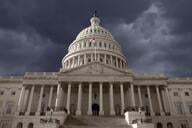You have /5 articles left.
Sign up for a free account or log in.

iStock
I teach a class on apocalyptic literature, and I like to joke that our primary text is the front page of the newspaper. Nuclear missile threats, melting ice caps, large-scale election tampering -- signs of doom dominate the headlines.
Lately, it feels like my role as a college counselor has taken on an apocalyptic tenor. A recent survey by Inside Higher Ed found that only 34 percent of colleges met their enrollment targets for this fall. Harvard Business School professor Clayton Christensen, who famously coined the term “disruptive innovation,” stated last May that in the next 10 to 15 years, half of America’s 4,000 colleges and universities will go bankrupt. And at the end of 2017, Moody’s downgraded its outlook for higher education from stable to negative, citing slow revenue growth and uncertainty at the federal level.
A Carleton College economist, Nathan Grawe, recently published Demographics and the Demand for Higher Education, which threatens to add one more log to the apocalyptic flames. His book takes as its jumping-off point the declining fertility rates after the 2008 economic recession. These rates amount to what he calls a “birth dearth,” a nearly 13 percent decline in the number of births, a figure that hasn’t rebounded over the past decade.
Grawe crunches the numbers at a granular level and develops a forecast model that shows what the decline will mean for higher education. Because the plummeting birth rates especially affect demographic groups and geographic regions with high college-going populations, the news is ominous for institutions of higher education, which will likely see a precipitous drop in demand for their product. In just four years at the end of the next decade, for example, the four-year college sector stands to lose 280,000 students.
Grawe’s forecasts do not suggest that lower numbers of prospective students will affect all colleges equally. The most elite institutions -- particularly those colleges with an established history of national and international appeal -- will likely see an increase in demand over today’s numbers. However, the majority of institutions, in order to maintain viable enrollments, will need to make large-scale adjustments by 2025, the year the generation that commenced the “birth dearth” will graduate high school. Without such changes, Grawe imagines that many tuition-dependent institutions, especially regional colleges, will struggle to remain open.
Despite these gloomy forecasts -- or perhaps because of them -- I believe the moment is ripe for some progressive reforms, changes that challenge the status quo in college admissions. The shifting landscape of higher education presents us with some opportunities. Instead of perpetuating the arms race for accolades earned by adolescents in the frenzy to win a spot at a selective college, the decline in the demand for colleges and universities may have benefits for students, who will face less competition at most two- and four-year institutions.
Colleges will have to recruit from new populations and provide financial incentives to earn the matriculation of those students. In addition, perhaps college admissions offices will focus less on metrics that alter their spot in the U.S. News rankings -- lower acceptance rates, for example -- and more on targeting the right students for their colleges.
Those of us on the high school side of college admissions can also make some changes. Recent research shows rising rates of anxiety in teens and higher numbers of adolescents with suicidal thoughts. As New York Times columnist Frank Bruni puts it, “many kids admitted into top schools are emotional wrecks or slavish adherents to soulless scripts that forbid the exploration of genuine passions.” Many colleges are acknowledging the need to make the college admissions process less taxing on applicants’ emotional well-being; elite high schools ought to do the same.
The Mastery Transcript Consortium's push to transform high school transcripts strikes me as the most exciting of these ventures. The MTC seeks to replace traditional high school transcripts -- the one-page list of classes and grades meant to represent four years of classroom experiences -- with something closer to a website for each student. This new mastery transcript would illustrate the skills developed by the student, such as analytical writing or digital literacy, rather than the grade achieved in traditional academic disciplines. Each earned credit would also include examples of the work the student completed to demonstrate proficiency in that skill. A student, for example, who earned a credit in creative communication might include a short story or musical composition as evidence of mastery.
The advantages to the mastery transcript are manifold. Instead of the more industrial model for evaluating students, structured on uniform Carnegie units and content areas, the mastery transcript is flexible and individualized. The B in English on a traditional transcript stands in clumsily for many different kinds of assignments and classroom experiences. A mastery credit names a more singular skill area -- active listening, perhaps, or applied technology use -- a student has cultivated and displayed effectively. These skills might also recognize noncognitive character traits, such as teamwork, integrity and persistence, qualities that honor the full humanity of adolescents.
For colleges that practice holistic admissions, the mastery transcript thus offers a more precise picture of each applicant’s strengths. Colleges would know that an applicant might be, for example, a creative problem solver who excels in explaining complex concepts to others but is challenged by organizational skills. That conveys a lot more than, say, a B-plus in European history ever will, and at a moment when grade inflation, especially at affluent schools, is rampant, the mastery transcript promises to be more meaningful than traditional letter grades.
Opponents argue that the mastery transcript will take too long for college application readers to digest. The MTC promises, however, that admissions offices will need no more than two minutes to process it.
Some of us actually hope that the transcript takes longer to read. Admissions offices seem to value efficiency and speed at a rate that’s wholly disproportionate with the investment teenagers make in applying to the college. The usual strategy for gaining admission to selective colleges -- straight A’s, more Advanced Placement courses, perfect test scores -- discourages creativity, undermines peer relationships and puts tremendous pressure on young people. The mastery transcript enables students to show who they are more authentically, and if doing so slows the review of a college application, perhaps, in the end, that’s not such a bad thing.
The selective college sorting process too often holds students hostage to a narrow idea of what “merit” means. An increasing number of school districts and even some states seem to agree, and the growing movement for “performance assessments” and standards-based learning in public high schools offer a useful corrective. These schools also seek to emphasize the development of skills through project-based learning rather than competency in traditional academic subjects. Districts all over New England and more than 40 in California have signed on, and major college admissions organizations are participating as well.
Likewise, the MTC now has nearly 200 member schools, including such prestigious institutions as Phillips Andover, Phillips Exeter and the Dalton School. (In the spirit of full disclosure, the school where I am employed is also a member of the MTC.) The upside of gathering these elite independent schools, along with those forward-thinking public school districts, is their power for influence. These high schools stand to pressure selective colleges to rethink what a college application looks like.
Given the coming demographic changes, most colleges will likely have to adjust, too. Empty dorms, abandoned classrooms, flickering lights -- the birth dearth spells an enrollment doomsday.
The four horsemen may come for many colleges. Let’s not let them ride off with the well-being of our students, too.




